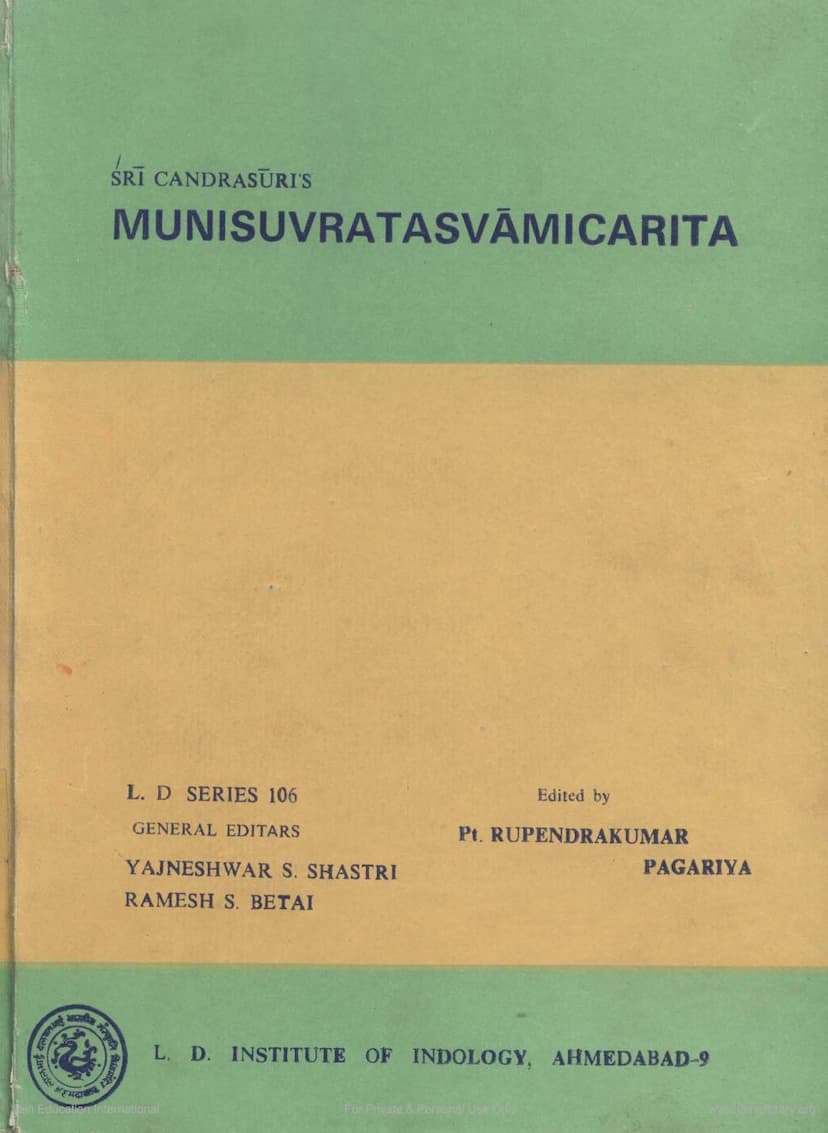Munisuvratasvamicarita
Added to library: September 2, 2025

Summary
Here's a comprehensive summary of the Jain text "Munisuvratasvamicarita" by Śrī Candrasūri, based on the provided text:
Book Title: Munisuvratasvamicarita Author: Ācārya Śrī Candrasūri Publisher: L. D. Institute of Indology, Ahmedabad Published: First Edition, April 1989
Overall Essence: The "Munisuvratasvamicarita" is a significant Jain religious-poetic work that details the nine lives of Munisuvratasvami, the 20th Tirthankara of the Jains. Authored by the prominent scholar and poet Ācārya Śrī Candrasūri, who was active in the late 12th century, the text is praised for its scholarship, poetic mastery, and engaging narrative style. It aims to present Jain philosophical and ethical doctrines through captivating stories in a simple, accessible manner, making it suitable for a wide range of readers. The work also highlights the author's deep understanding of Prakrit composition, grammar, rhetoric, and descriptive arts, characteristic of a Mahakavya.
Key Aspects and Contributions:
- Hagiographical Account: The book follows the established Jain tradition of writing biographies of Tirthankaras and other significant spiritual figures (Salākā-puruṣas). It focuses on the nine important births of Munisuvratasvami, including his first life as Sivaketu and his final life as the Tirthankara.
- Literary Merit: Candrasūri is lauded for his profound scholarship and erudition, evident in his masterful narration, fine descriptions, and the overall adherence to the traits of a Mahakavya. The work is written in Prakrit and comprises approximately 10,995 Gāthā verses, primarily in the Āryā meter, with some Sanskrit verses for stuti (praise).
- Philosophical and Ethical Exposition: The narrative medium effectively conveys Jain philosophical principles and ethical doctrines, making them understandable to interested readers. The text emphasizes themes like reincarnation, karma, self-purification, liberation, virtue, discipline, and spiritual conduct.
- Author's Background: Ācārya Śrī Candrasūri was a disciple of Acharya Vibdhachandra Sūri and a contemporary of the great Acharya Hemachandrasūri. Before his spiritual life, he served as the Finance Minister to the Caulukya king Jayasimha of Gujarat. This background likely influenced his ability to produce an extensive and well-structured literary work.
- Editorial Endeavor: The critical edition, edited by Pt. Rupendrakumar Pagariya, is based on valuable manuscripts, including one copied shortly after the work's completion and under the author's supervision. The editor's introduction in Hindi is considered enlightening. The L. D. Institute of Indology and its directors, Yajneshwar S. Shastri and Ramesh S. Betai, are commended for their role in publishing this work.
- Illustrative Narratives: The text is enriched with several interesting episodes and illustrative stories that shed light on Jain narratives and cultural traditions. Notable among these are:
- The Enlightened Horse: Legends connected to the Suvratasvami temple at Bhrugukaccha, including the enlightenment of a royal horse.
- The Bali-Vamana Legend: A Jainistic version of the Purānic Bali-Vāmana story, presented through the episode of Minister Namuci and Viṣnu-muni.
- King Ambūvici: An episode illustrating how even a seemingly "worthless" person can attain honor and prestige through good fortune and the support of capable individuals. This story is noted for its echo in later folk traditions, as seen in the Puratana-prabhadha-Samgraha.
- The Papagāyaka (Meritorious Parrot): A story about parrots who repay kindness, emphasizing that even animals strive to be indebted to their benefactors, highlighting a moral lesson for humans.
- The Tale of King Harsa Pāla: Illustrating the law of karma and destiny through the king's interaction with his beautiful daughter Anupama and the prophecies surrounding her son.
- King Chandra Kirti: The story of King Chandra Kirti, who rose to prominence through his devotion to Jain principles in a previous life.
- The Episode of Kartik Seth: A tale of unwavering devotion to Jain principles, even when facing insult and humiliation.
- The Vishnu Muni and Namuci Incident: Illustrating the concept of karma and divine intervention, particularly relevant to the Tirthankara's previous lives and the power of righteousness.
- The Horse and Bhrugukaccha Temple: The story of the horse enlightened by Munisuvratasvami and the origin of the famous pilgrimage site at Bhrugukaccha (Bharuch).
- The Kings Ambuvici and Vici: The story of a king with limited speech, illustrating how even seemingly simple individuals can be guided by destiny and capable ministers. The story of Ambucica and the contrasting fates of Vidura and the king, as described in Puratana-prabhadha-Samgraha, is also discussed, highlighting the evolution of folk legends.
- Author's Lineage: The preface meticulously traces Candrasuri's guru lineage, starting with Jayasimha Suri, followed by the influential Maladhāri Abhayadeva Suri, and then the renowned Hemachandrasuri. This lineage underscores the intellectual and spiritual tradition from which Candrasuri emerged.
- Tirthankara's Life Details: The text provides details about Munisuvratasvami's various lifetimes, including his parents (Sumitra and Padmavati), lineage (Harivamsa), birth details, his adherence to Jain principles, the circumstances of his renunciation, his attainment of Kevala Jnana (omniscience), the establishment of the Jain order, and his Nirvana.
- Comparison with Other Texts: The summary notes that while Agamic literature contains brief mentions of Munisuvratasvami, the Munisuvratasvamicarita offers a much more extensive and detailed account of his nine births. It also references other biographical works on Munisuvratasvami and mentions differences in narratives between Candrasuri's work and texts like the Uttarapurana.
In essence, "Munisuvratasvamicarita" stands as a monumental contribution to Jain literature, offering a rich blend of devotion, philosophy, and literary artistry, bringing to life the profound spiritual journey of Tirthankara Munisuvratasvami.